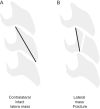Treatment of unilateral cervical facet fractures without evidence of dislocation or subluxation: a narrative review and proposed treatment algorithm
- PMID: 38457922
- PMCID: PMC10958245
- DOI: 10.1530/EOR-23-0161
Treatment of unilateral cervical facet fractures without evidence of dislocation or subluxation: a narrative review and proposed treatment algorithm
Abstract
Isolated cervical spine facet fractures are often overlooked. The primary imaging modality for diagnosing these injuries is a computed tomography scan. Treatment of unilateral cervical facet fractures without evidence of dislocation or subluxation remains controversial. The available evidence regarding treatment options for these fractures is of low quality. Risk factors associated with the failure of nonoperative treatment are: comminution of the articular mass or facet joint, acute radiculopathy, high body mass index, listhesis exceeding 2 mm, fragmental diastasis, acute disc injury, and bilateral fractures or fractures that adversely affect 40% of the intact lateral mass height or have an absolute height of 1 cm.
Keywords: Spine; cervical facet fracture; isolated; non-displaced; trauma.
Conflict of interest statement
The authors declare that there is no conflict of interest that could be perceived as prejudicing the impartiality of this review.
Figures




Similar articles
-
Use of computed tomography to predict failure of nonoperative treatment of unilateral facet fractures of the cervical spine.Spine (Phila Pa 1976). 2006 Nov 15;31(24):2827-35. doi: 10.1097/01.brs.0000245864.72372.8f. Spine (Phila Pa 1976). 2006. PMID: 17108837
-
The management of unilateral lateral mass/facet fractures of the subaxial cervical spine: the use of magnetic resonance imaging to predict instability.Spine (Phila Pa 1976). 1997 Nov 15;22(22):2614-21. doi: 10.1097/00007632-199711150-00007. Spine (Phila Pa 1976). 1997. PMID: 9399446
-
Risk Factors for Failure of Nonoperative Treatment for Unilateral Cervical Facet Fractures.Asian Spine J. 2017 Jun;11(3):356-364. doi: 10.4184/asj.2017.11.3.356. Epub 2017 Jun 15. Asian Spine J. 2017. PMID: 28670403 Free PMC article.
-
Risk Factors for Failure of Non-operative Management in Isolated Unilateral Non-displaced Facet Fractures of the Subaxial Cervical Spine: Systematic Review and Meta-Analysis.Global Spine J. 2025 May;15(4):2467-2479. doi: 10.1177/21925682241304351. Epub 2024 Nov 26. Global Spine J. 2025. PMID: 39588912 Free PMC article. Review.
-
Management of unilateral locked facet of the cervical spine.Neurosurgery. 1993 Nov;33(5):832-7; discussion 837. doi: 10.1227/00006123-199311000-00007. Neurosurgery. 1993. PMID: 8264879 Review.
Cited by
-
Esophageal perforation more than 10 years after anterior cervical spine surgery: a case report and literature review.EFORT Open Rev. 2025 Jan 3;10(1):57-63. doi: 10.1530/EOR-24-0110. Print 2025 Jan 1. EFORT Open Rev. 2025. PMID: 40071924 Free PMC article. Review.
References
Publication types
LinkOut - more resources
Full Text Sources

